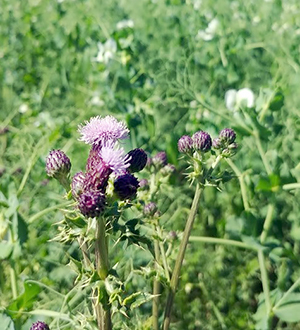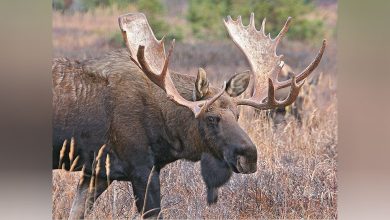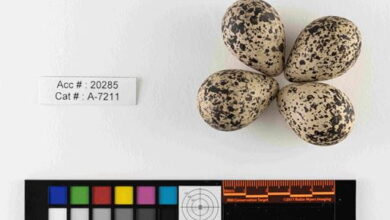
Using Weed Biology to Get the Most Out of Fall Weed Control
By Keana Boere, Summer Student, Regional Services Branch, North Battleford
Fall can provide a good opportunity to control perennial or winter annual weeds that may have become problematic in your fields. Herbicides are a good control option but there are situations when herbicides are not feasible or permitted for use. Examples of these situations include wetland buffer zones, organic cropping systems, areas where weeds are too large to spray, when a good herbicide option is not available or when harvest or fall seeding of a crop prevents their use.
The growth habits of perennial and winter annual weeds have an impact on how they are best controlled. Perennial weeds are long-lived plants that can survive for many growing seasons and can reproduce by underground stems/rhizomes and/or by seed production. Common perennial weeds include Canada thistle, perennial sow thistle, dandelion and tansy. In contrast, a winter annual establishes in spring or fall to form a rosette and requires a dormant season to finishing flowering and set seed to complete their lifecycle. These weeds include shepherd’s purse, downy brome, stinkweed and flixweed. However, some problematic weeds such as scentless chamomile are very adaptable to their environment and can modify their life cycles to be winter annuals or perennial weeds. The best weed control management strategies understand the biology of a plant to maximize their effectiveness.
Best management practices for non-herbicide control of perennial weeds and winter annual weeds in annually cropped fields rely on agronomic practices such as crop choice, growth habit and competitiveness.
Crop Choice
Crop type can help shift the weed composition in the field so the same weed species are not dominant each year. Fall seeded crops will be more competitive against winter annual weeds by providing more competition in the fall and following spring before other weed control options such as tillage or herbicides can be used. Often winter annual weeds will have flowered and set seed before a spring crop has even emerged. Seeding a perennial forage crop can help establish a dense plant canopy that can reduce the amount of light reaching the soil surface, therefore, suppressing weed seedlings and preventing germination. Rotations of different crops can vary the timing of weed control. Seeding crops that can be harvested earlier such as peas, lentils, winter cereals, and crops grown for silage allow for an earlier window to control weeds by a non-selective herbicide and/or tillage later in the growing season.
Crop Competitiveness
Different crops vary in their competitiveness based on their ability to quickly emerge and produce a dense plant canopy. For example, fall rye is more competitive than canola or lentils (Figure 1) because it establishes in the fall for early spring growth and produces tillers. Seeding rates can be used to produce dense crop stands that shade out weeds and leave less soil available for weeds to germinate in.
Fall Rye > Oats > Barley > Wheat > Canola > Field Peas > Flax > Lentil
Tillage
Tillage is most successful when it is persistent and timely. Often, tillage operations need to be done repeatedly to deplete root reserves of carbohydrates. Perennial weeds are most vulnerable when their root reserves of carbohydrates are low (Figure 2). For example, for control of Canada thistle in a spring seeded field, key timings for control are in the spring and fall. In the spring, repeated tillage is best done from early growth in the growing season to flowering (point 2) as plants are using up root reserves for growth and development of flowers and seed heads. During seed maturation and senescence root reserves are built back up in the plant making tillage not as effective right after flowering. Another opportunity for reducing root reserves occurs in the fall (point 5) after crops are harvested when regrowth on plants can occur to supply weeds with much needed carbohydrates for winter survival. Repeated tillage is best optimized at this time to keep green growth from reoccurring. Often a single tillage operation can result in plant roots being cut into smaller pieces and spread over a larger area which can increases the patch size. For example, a Canada thistle root fragment that is only half an inch in size can produce an entirely new shoot. Therefore, it is important that the first tillage pass is followed up with additional tillage operations to continue to deplete root reserves and prevent a lot of green growth from reoccurring.

(Source : Nordell, A. et al. Cultivating Questions: Canada Thistle, Small Farmers Journal Issue 33-4.)
Fall is an important time to control perennial and winter annual weeds. By understanding the life cycles of perennial and winter annual weeds, the timing of weed control can make it more effective. Agronomic decisions such as crop choice, crop competitiveness, and tillage are effective strategies that can be used to manage these problem weeds alone or in conjunction with herbicides.
For the latest information and for more updates on everything Kindersley ‘Like’ the Kindersley Social Facebook page below…








































